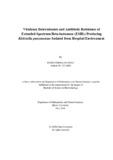| dc.contributor.advisor | Hossain, Mahboob | |
| dc.contributor.advisor | Mahmud, Zahid Hayat | |
| dc.contributor.author | Costa, Dorin Teresa D. | |
| dc.date.accessioned | 2020-08-06T08:58:00Z | |
| dc.date.available | 2020-08-06T08:58:00Z | |
| dc.date.copyright | 2019 | |
| dc.date.issued | 2019 | |
| dc.identifier.other | ID 15136006 | |
| dc.identifier.uri | http://hdl.handle.net/10361/13903 | |
| dc.description | This thesis is submitted in partial fulfillment of the requirements for the degree of Bachelor of Science in Biotechnology, 2019. | en_US |
| dc.description | Cataloged from PDF version of thesis. | |
| dc.description | Includes bibliographical references (pages 49-52). | |
| dc.description.abstract | Klebsiella pneumonia is a member of gram-negative Enterobacteriaceae associated with community and hospital-acquired infections through highly resistant clones. Infection by Carbapenem-resistant Klebsiella is increasing day by day at an alarming rate. Occurrence of nosocomial bacterial infections affecting neonates, elderly and immune-compromised people has been increased from 8% to 40% in recent times. Hyper-virulent K. pneumoniae causes community-acquired infections in healthy individuals. In this study, the isolates were collected from different hospital environments for the detection of virulence genes and to see the antibiotic resistance of those samples. Antibiotic susceptibility to beta-lactams was tested for a total of 39 clinical isolates from 115 K. pneumoniae samples of different hospitals in Bangladesh. In this study, K. pneumoniae showed resistant to Cefexime(100%), Azetronam(69%), Tetracycline(66%), Nalidixic acid(61%) and Cefepime(53%). Resistance to Imipenem and Meropenem was 15% and 35% respectively. The majority of K. pneumoniae isolates characterized in the present study were resistant to different groups of antibiotics. On the other hand, for the detection of virulence genes, multiplex PCR was done on two sets. One of them included fimH, ureA, kfubc and other other one contained uge and wabG primers. Among the 115 samples, 35 samples were selected randomly for virulence gene detection. About 33% of them exhibited fimH, about 25% Uge and 42% of them showed wabG. CR-KP organisms are resistant to all beta-lactams. K. pneumoniae strains possess a serious threat to the immunosuppressive patient. This study was to observe the current status of the antibiogram of carbapenem-resistant and extended-spectrum beta-lactamases (ESBL) producing K pneumonia and the molecular detection of these organisms collected from the hospital environments. The outcome of this study also provided new insights into the pathogenesis and the resistance of K. pneumoniae. | en_US |
| dc.description.statementofresponsibility | Dorin Teresa D. Costa | |
| dc.format.extent | 52 pages | |
| dc.language.iso | en | en_US |
| dc.publisher | Brac University | en_US |
| dc.rights | Brac University theses are protected by copyright. They may be viewed from this source for any purpose, but reproduction or distribution in any format is prohibited without written permission. | |
| dc.subject | Klebsiella pneumonia | en_US |
| dc.subject | Enterobacteriaceae | en_US |
| dc.subject | Carbapenem-resistant Klebsiella | en_US |
| dc.subject | Extended-spectrum beta-lactamases (ESBL) | en_US |
| dc.subject.lcsh | Microbiology | |
| dc.subject.lcsh | Beta lactamases. | |
| dc.title | Virulence determinants and antibiotic resistance of Extended-Spectrum Beta-lactamase (ESBL) producing Klebsiella pneumoniae Isolated from hospital environment | en_US |
| dc.type | Thesis | en_US |
| dc.contributor.department | Department of Mathematics and Natural Sciences, Brac University | |
| dc.description.degree | B. Biotechnology | |

